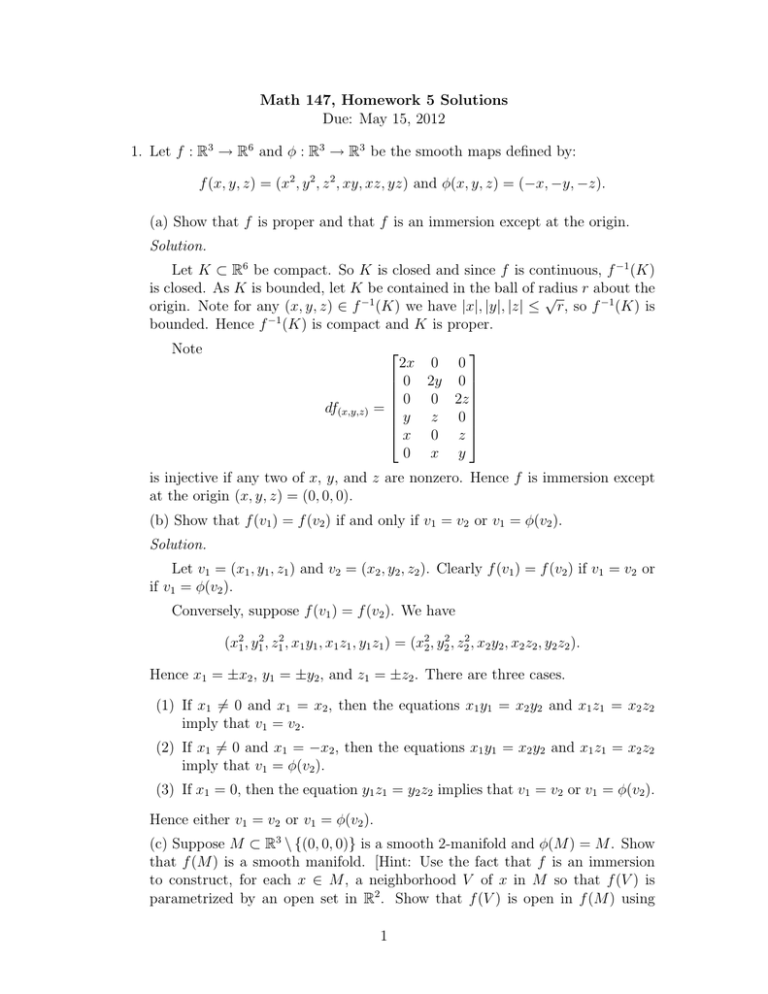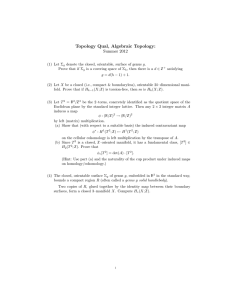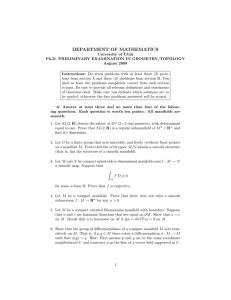Math 147, Homework 5 Solutions Due: May 15, 2012 → R
advertisement

Math 147, Homework 5 Solutions
Due: May 15, 2012
1. Let f : R3 → R6 and φ : R3 → R3 be the smooth maps defined by:
f (x, y, z) = (x2 , y 2 , z 2 , xy, xz, yz) and φ(x, y, z) = (−x, −y, −z).
(a) Show that f is proper and that f is an immersion except at the origin.
Solution.
Let K ⊂ R6 be compact. So K is closed and since f is continuous, f −1 (K)
is closed. As K is bounded, let K be contained in the ball of radius
r about the
√
−1
origin. Note for any (x, y, z) ∈ f (K) we have |x|, |y|, |z| ≤ r, so f −1 (K) is
bounded. Hence f −1 (K) is compact and K is proper.
Note
df(x,y,z)
2x 0 0
0 2y 0
0 0 2z
=
y z 0
x 0 z
0 x y
is injective if any two of x, y, and z are nonzero. Hence f is immersion except
at the origin (x, y, z) = (0, 0, 0).
(b) Show that f (v1 ) = f (v2 ) if and only if v1 = v2 or v1 = φ(v2 ).
Solution.
Let v1 = (x1 , y1 , z1 ) and v2 = (x2 , y2 , z2 ). Clearly f (v1 ) = f (v2 ) if v1 = v2 or
if v1 = φ(v2 ).
Conversely, suppose f (v1 ) = f (v2 ). We have
(x21 , y12 , z12 , x1 y1 , x1 z1 , y1 z1 ) = (x22 , y22 , z22 , x2 y2 , x2 z2 , y2 z2 ).
Hence x1 = ±x2 , y1 = ±y2 , and z1 = ±z2 . There are three cases.
(1) If x1 6= 0 and x1 = x2 , then the equations x1 y1 = x2 y2 and x1 z1 = x2 z2
imply that v1 = v2 .
(2) If x1 6= 0 and x1 = −x2 , then the equations x1 y1 = x2 y2 and x1 z1 = x2 z2
imply that v1 = φ(v2 ).
(3) If x1 = 0, then the equation y1 z1 = y2 z2 implies that v1 = v2 or v1 = φ(v2 ).
Hence either v1 = v2 or v1 = φ(v2 ).
(c) Suppose M ⊂ R3 \ {(0, 0, 0)} is a smooth 2-manifold and φ(M ) = M . Show
that f (M ) is a smooth manifold. [Hint: Use the fact that f is an immersion
to construct, for each x ∈ M , a neighborhood V of x in M so that f (V ) is
parametrized by an open set in R2 . Show that f (V ) is open in f (M ) using
1
properness of f .]
This problem shows that the Möbius band f (S 1 × R), the real projective plane
f (S 2 ) and the Klein bottle f (Y ) where Y ⊂ R3 is the surface of revolution
diffeomorphic to S 1 × S 1 you studied in Homework 1 are all smooth manifolds.
Solution.
Let x ∈ M . To show that f (M ) is a smooth manifold, we must find an
open neighborhood about f (x) ∈ f (M ) that is diffeomorphic to R2 . Let V
be an open neighborhood about x in M diffeomorphic to R2 . By the Local
Immersion Theorem on page 15 of Guillemin and Pollack, we can make V
smaller if necessary to get that f is locally equivalent to the canonical immersion
on V , and hence f maps V diffeomorphically onto its image f (V ). Hence f (V )
contains f (x) and is diffeomorphic to R2 . It remains to show that f (V ) is open
in f (M ).
To show that f (V ) is open in f (M ), we first show that f : M → f (M ) is
a closed map. To do this, we use the fact that f is proper and the fact that
f (M ) is compactly generated (since R6 is). Let C ⊂ M be closed. Since f (M )
is compactly generated, to show that f (C) is closed in f (M ) we need only show
that f (C) ∩ K is closed for every subset K in f (M ). So let K ⊂ f (M ) be
compact. Then f −1 (K) is compact because f is proper, and so C ∩ f −1 (K) is
a closed subset of a compact space, hence compact. Since f is continuous,
f (C ∩ f −1 (K)) = f (C) ∩ K
is also compact, hence closed in M . This shows that f : M → f (M ) is a closed
map.
Now, since V is open in M , so is V ∪ φ(V ), and hence the complement
M \ (V ∪ φ(V )) is closed. Hence f (M \ (V ∪ φ(V ))) = f (M ) \ f (V ) is closed in
f (M ), since f : M → f (M ) is a closed map. So f (V ) is open in f (M ) and we
are done.
2. Suppose f : M → N is a smooth map between manifolds of the same dimension
with M compact without boundary and N connected.
(a) Show that deg2 (f ) = 0 if N has non-empty boundary. [Hint: Construct
a connected manifold N 0 strictly containing N and show deg2 (f 0 ) = 0 for the
composition f 0 of f with the inclusion N ⊂ N 0 .]
Solution.
First we’ll construct a compact connected manifold N 0 strictly containing N .
Let N be a manifold of dimension n in Rk . Let x be a point in the boundary
of N . Let g : V → U be a diffeomorphism, where V is an open set in H n ,
where U is an open set set in N , and where g(0) = x. Since g is smooth, g
can be extended to a smooth map G on an open set V 0 in Rn that contains V .
Since dg0 = dG0 is non-singular, we may assume G is a diffeomorphism onto
its image after making V 0 smaller if necessary. Again after making V 0 smaller
2
if necessary, we may assume that G(V 0 ) ∩ N = U . Using problem 6(d) on
Homework 2, construct a bump function φ : Rn−1 → R such that if y ∈ Rn−1
and φ(y) 6= 0, then (y, φ(y) ∈ V 0 . See the picture below. Let
Vφ0 = {(y, t) ∈ Rn−1 × R | t ≤ φ(y)} ∩ V 0
be the points in Rn under the graph of φ, intersected with V 0 .
Then N 0 = N ∪ G(Vφ0 ) is a compact connected manifold strictly containing N .
Now let f 0 : M → N 0 be the composition of f with the inclusion N ⊂ N 0 .
Let y ∈ N 0 \ N , and note that y is a regular value of f 0 with #f 0−1 (y) = 0. Let
z ∈ N be a regular value of f . Note that z is also in N 0 , that z is also a regular
value of f 0 , and that #f −1 (z) = #f 0−1 (z). We have
deg2 (f ) ≡ #f −1 (z) mod 2
≡ #f 0−1 (z) mod 2
≡ #f 0−1 (y) mod 2 by the theorem on page 24 of Milnor
≡ 0 mod 2.
(b) Show that deg2 (f ) = 0 if N is not compact.
Solution.
Since M is compact and f is continuous, f (M ) is compact. Since N is not
compact, N \f (M ) must be nonempty, so there exists some point y ∈ N \f (M ).
Note that y is a regular value of f with #f −1 (y) = 0. Hence deg2 (f ) = 0.
3. A manifold M is contractable if the identity map on M is smoothly homotopic
to a constant map.
(a) Show that Rn is contractable for every n.
Solution.
3
Define H : Rn × I → Rn by H(x, t) = (1 − t)x. Note that H is a smooth
map, that H(x, 0) = x for all x, and that H(x, 1) = 0 for all x. Hence H is a
smooth homotopy from the identity map on Rn to a constant map.
(b) Show that no compact manifold without boundary is contractable other
than the one-point space.
Solution.
Let M be a compact manifold without boundary. Let id : M → M be the
identity map and let c : M → M be the constant map to some point x ∈ M . If
M is not the one-point space, then there is some point y 6= x ∈ M . Note that
y is a regular value of both id and c, that 1 = #id−1 (y), that 0 = #c−1 (y), and
that
#id−1 (y) 6≡ #c−1 (y) mod 2.
Therefore by the Homotopy Lemma on page 21 of Milnor, maps id and c are
not smoothly homotopic. Hence no compact manifold without boundary is
contractible other than the one-point space.
4. Let Y ⊂ R3 be the surface of revolution diffeomorphic to S 1 × S 1 you studied in
Homework 1. Describe an orientation on Y and give positively oriented bases
for:
T Y(3,0,0) , T Y(1,√3,1) , and T Y(−1,√3,1) .
Solution.
Let g : R2 → Y be given by
g(u, v) = (2 + cos v) cos u, (2 + cos v) sin u, sin v .
Recall from the solutions of homework 1 problem 5 that we can restrict the domain of g to two different open subsets of R2 to give two local parameterizations
of Y that together cover all of Y . Note
∂g
(u, v) = −(2 + cos v) sin u, (2 + cos v) cos u, 0
∂u
and
∂g
(u, v) = − sin v cos u, − sin v sin u, cos v .
∂v
Then we can choose
n
o
−(2 + cos v) sin u, (2 + cos v) cos u, 0 , − sin v cos u, − sin v sin u, cos v
to be a positively oriented basis for T Yg(u,v) . This describes a an orientation on
Y.
Since (3, 0, 0) = g(0, 0), a positively oriented basis for T Y(3,0,0) is given by
(0, 3, 0), (0, 0, 1) .
4
√
Since (1, 3, 1) = g(π/3, π/2), a positively oriented basis for T Y(1,√3,1) is given
by
√
√
(− 3, 1, 0), (−1/2, − 3/2, 0) .
√
Since (−1, 3, 1) = g(2π/3, π/2), a positively oriented basis for T Y(−1,√3,1) is
given by
√
√
(− 3, −1, 0), (1/2, − 3/2, 0) .
5. Show that the orthogonal group O(n) and special linear group SLn (R) are orientable.
Solution.
First we claim that if M is a manifold of dimension m and M × Rm is diffeomorphic to T M , then M is orientable. To see this, let f : M × Rm → T M be a
diffeomorphism which acts by sending (x, v) ∈ M ×Rm to f (x, v) = (x, fx (v)) ∈
T M . Note that fx (v) ∈ T Mx . Let {e1 , . . . , em } be the standard basis for Rm .
Then we can choose {fx (e1 ), . . . , fx (em )} to be a positively oriented basis for
T Mx . This gives a smooth choice of orientation for all tangent spaces, and
hence M is orientable.
We will show that O(n) × Rn(n−1)/2 is diffeomorphic to T O(n). Let I ∈ O(n)
be the identity matrix. For any matrix g ∈ O(n), define Lg : O(n) → O(n) by
Lg (h) = gh. Note this map is a diffeomorphism with inverse Lg−1 . Since
Lg (I) = g, map Lg induces a vector space isomorphism d(Lg )I : T O(n)I →
T O(n)g . Hence we can construct a diffeomorphism φ : O(n)×T O(n)I → T O(n)
given by φ(g, v) = (g, Lg (v)). Note that O(n) × T O(n)I is diffeomorphic to
O(n) × Rn(n−1)/2 . Hence O(n) × Rn(n−1)/2 is diffeomorphic to T O(n), so by the
above paragraph O(n) is orientable.
2
The same argument shows that SLn (R)×Rn −1 is diffeomorphic to T SLn (R).
Hence SLn (R) is orientable by the first paragraph.
(In fact, if M is any Lie group of dimension m, then M ×Rm is diffeomorphic
to T M and hence M is orientable.)
5






